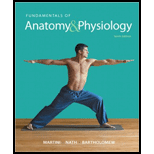
Fundamentals of Anatomy and Physiology - Package
10th Edition
ISBN: 9780134589688
Author: Martini
Publisher: PEARSON
expand_more
expand_more
format_list_bulleted
Concept explainers
Question
Chapter 2, Problem 22CP
Summary Introduction
To define:
The term proteins.
Introduction:
Proteins are organic compounds containing monomer units of amino acid residues. Amino acids contain a central carbon atom, a hydrogen atom, an amino group(NH2), a carboxyl group (-COOH), and an R-group. Proteins are the essential part of all living organisms and are the major components of body tissues (muscle,hair, etc.).
Expert Solution & Answer
Want to see the full answer?
Check out a sample textbook solution
Students have asked these similar questions
Describe a protein.
Describe the structure of proteins, and relate to its function.
Define big and tiny proteins.
Chapter 2 Solutions
Fundamentals of Anatomy and Physiology - Package
Ch. 2 - Define atom.Ch. 2 - Atoms of the same element that have different...Ch. 2 - How is it possible for two samples of hydrogen to...Ch. 2 - Prob. 4CPCh. 2 - Prob. 5CPCh. 2 - Both oxygen and neon are gases at room temperature...Ch. 2 - Prob. 7CPCh. 2 - Prob. 8CPCh. 2 - Prob. 9CPCh. 2 - Prob. 10CP
Ch. 2 - What is an enzyme?Ch. 2 - Prob. 12CPCh. 2 - Prob. 13CPCh. 2 - Explain how the chemical properties of water make...Ch. 2 - Define pH, and explain how the pH scale relates to...Ch. 2 - What is the significance of pH in physiological...Ch. 2 - Define the following terms: acid, base, and salt.Ch. 2 - Prob. 18CPCh. 2 - Prob. 19CPCh. 2 - Describe lipids.Ch. 2 - Prob. 21CPCh. 2 - Prob. 22CPCh. 2 - Prob. 23CPCh. 2 - Describe a nucleic acid.Ch. 2 - Prob. 25CPCh. 2 - Describe ATP.Ch. 2 - What molecule is produced by the phosphorylation...Ch. 2 - 28. Identify the biochemical building blocks...Ch. 2 - 29. Define metabolic turnover.
Ch. 2 - An oxygen atom has eight protons (a) Sketch in the...Ch. 2 - What is the following type of decomposition...Ch. 2 - The subatomic particle with the least mass (a)...Ch. 2 - Isotopes of an element differ from each other in...Ch. 2 - The number and arrangement of electrons in an...Ch. 2 - All organic compounds in the human body contain...Ch. 2 - A substance containing atoms of different elements...Ch. 2 - All the chemical reactions that occur in the human...Ch. 2 - Which of the following chemical equations...Ch. 2 - Prob. 10RQCh. 2 - A pH of 7.8 in the human body typifies a condition...Ch. 2 - A(n) _____ is a solute that dissociates to release...Ch. 2 - Special catalytic molecules called _____ speed up...Ch. 2 - Which of the following is not a function of a...Ch. 2 - Complementary base pairing in DNA includes the...Ch. 2 - What are the three subatomic panicles in atoms?Ch. 2 - Prob. 17RQCh. 2 - Prob. 18RQCh. 2 - List seven major functions performed by proteins.Ch. 2 - (a) What three basic components make up a...Ch. 2 - What three components are required to create the...Ch. 2 - If a polypeptide contains 10 peptide bonds, how...Ch. 2 - Prob. 23RQCh. 2 - Prob. 24RQCh. 2 - What is a salt? How does a salt differ from an...Ch. 2 - Prob. 26RQCh. 2 - In an exergonic reaction, (a) large molecules are...Ch. 2 - Prob. 28RQCh. 2 - Prob. 29RQCh. 2 - An atom of the element calcium has 20 protons and...Ch. 2 - A certain reaction pathway consists of four steps....Ch. 2 - Prob. 32RQCh. 2 - Prob. 1CCCh. 2 - Prob. 2CC
Knowledge Booster
Learn more about
Need a deep-dive on the concept behind this application? Look no further. Learn more about this topic, biology and related others by exploring similar questions and additional content below.Similar questions
arrow_back_ios
SEE MORE QUESTIONS
arrow_forward_ios
Recommended textbooks for you


Macromolecules | Classes and Functions; Author: 2 Minute Classroom;https://www.youtube.com/watch?v=V5hhrDFo8Vk;License: Standard youtube license